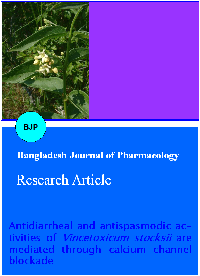Antidiarrheal and antispasmodic activities of Vincetoxicum stocksii are mediated through calcium channel blockade
DOI:
https://doi.org/10.3329/bjp.v6i1.8403Keywords:
Vincetoxicum stocksii, mice, rabbit jejunum, Ca antagonistAbstract
This study was carried out to explore the mechanism underlying antidiarrheal and antispasmodic activities of Vincetoxicum stocksii. The crude extract of V. stocksii provided 12-24% protection from castor oil-induced diarrhea at the dose of 300-1,000 mg/kg, similar to loperamide. In isolated rabbit jejunum preparations, V. stocksii caused inhibition of the spontaneous and high K+ (80 mM)-induced contractions, with respective EC50 values of 2.53 (1.65-3.90) and 0.95 mg/mL (0.63-1.42), similar to that caused by verapamil, suggesting the calcium channel blocking effect. Loperamide caused inhibition of spontaneous and high K+-induced contraction, with respective EC50 values of 8.59 (6.33-10.11) and 9.12 µM (7.33-12.81). The calcium channel blocking activity was further confirmed when pretreatment of the tissues with V. stocksii (1-3 mg/mL) caused a rightward displacement of the Ca++ concentrations response curves, similar to that produced by verapamil; constructed in Ca++ free medium. These data indicate that the crude extract of V. stocksii contains calcium channel blocking constituents that may possibly explain its medicinal use in hyperactive states of gut, such as, diarrhea and spasms.
Downloads
1745
724 Read
336
References
Awouters F, Niemegeers CJE, Lenaerts FM, Janssen PAJ. Delay of castor oil diarrhea in rats, a new way to evaluate inhibitors of prostaglandin biosynthesis. J Pharm Pharmacol. 1978; 30: 41-45.
Bolton TB. Mechanism of action of transmitters and other substances on smooth muscles. Physiol Rev. 1979; 59: 606-718.
Pasricha PJ. Agents affecting gastrointestinal water flux and motility; emesis and antiemetics; bile acids and pancreatic enzymes. In: Brunton LL, Lazo JS, Parker KL (Eds.), Goodman and Gillman's: The Pharmacological Basis of Therapeutics. McGraw Hill, New York, 2006, pp 983-1008.
Croci T, Landi M, Edmonds-Alt X, Le Fur G, Maffrand JP, Manara I. Role of tachykinins in castor oil induced diarrhea in rats. Br J Pharmacol. 1997; 121: 375-80.
Farre AJ, Columbo M, Fort M, Gutierrez B. Differential effects of various Ca++ antagonists. Gen Pharmacol. 1991; 22: 177-81.
Gilani AH, Shaheen F, Saeed SA. Cardiovascular actions of Daucus carota. Arch Pharmacal Res. 1994; 17: 150-53.
Gilani AH, Shah AJ, Ghayur MN, Kashif M. Pharmacological basis for the use of turmeric in gastrointestinal and respiratory disorders. Life Sci. 2005; 76: 3089-105.
Godfraind T, Miller R, Wibo M. Calcium antagonism and calcium entry blockade. Pharmacol Rev. 1986; 38: 321-416.
Iwao I, Terada Y. On the mechanism of diarrhea due to castor oil. Jpn J Pharmacol. 1962; 12: 137-45.
Jebunnessa, Uddin SB, Mahbub-Uz-Zaman M, Akatr R, Ahmed NU. Antidiarrheal activity of ethanolic bark extract of Mitragyna diversifolia. Bangladesh J Pharmacol. 2009; 4: 144-46.
National Research Council. Guide for the care and use of laboratory animals. National Academies Press, Washington DC, 2010. pp 161-175.
Reynolds IJ, Gould RJ, Snyder SH. Loperamide blockade of calcium channel as mechanism for antidiarrheal effects. J Exp Pharmacol Ther. 1984; 231: 628-32.
Shah AJ, Bhulani NN, Khan SH, Rehman N, Gilani AH. Calcium channel blocking activity of Mentha longifolia L. explains its medicinal use in diarrhea and gut spasm. Phytother Res. 2010; 24: 1392-97.
van-Rossum JM. Cumulative dose-response curves. II. Techniques for the making of dose-response curves in isolated organs and the evaluation of drug parameters. Arch Int Pharmacodyn. 1963; 143: 299-330.
Wall ME, Eddy CR, McClenna ML, Klump ME. Detection and estimation of steroid and sapogenins in plant tissue. Anal Chem. 1952; 24: 1337-42.
Zhu M, Phillipson JD, Greengrass PM, Bowery NE, Cai Y. Plant polyphenols: biologically active compounds or non-selective binders to proteins? Phytochemistry. 1997; 44: 441-47.
Zaidi MA, Crow SA Jr. Biologically active traditional medicinal herbs from Balochistan, Pakistan. J Ethnopharmacol. 2005; 96: 331-34.

Published
How to Cite
Issue
Section
License
Authors who publish with this journal agree to the following terms:
- Authors retain copyright and grant the journal right of first publication with the work simultaneously licensed under a Creative Commons Attribution License that allows others to share the work with an acknowledgement of the work's authorship and initial publication in this journal.
- Authors are able to enter into separate, additional contractual arrangements for the non-exclusive distribution of the journal's published version of the work (e.g., post it to an institutional repository or publish it in a book), with an acknowledgement of its initial publication in this journal.
- Authors are permitted and encouraged to post their work online (e.g., in institutional repositories or on their website) prior to and during the submission process, as it can lead to productive exchanges, as well as earlier and greater citation of published work (See The Effect of Open Access).
